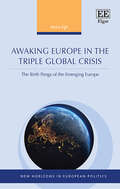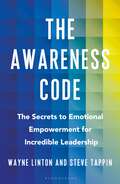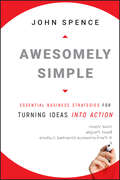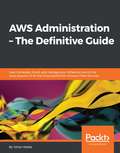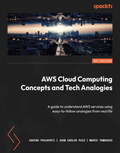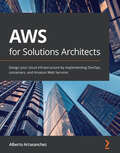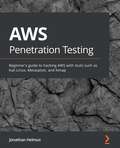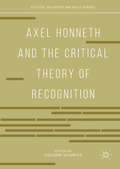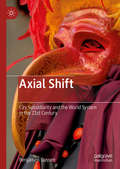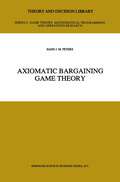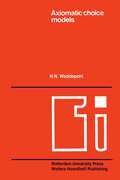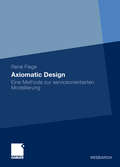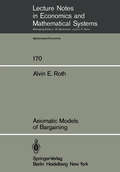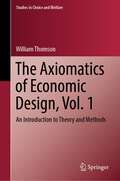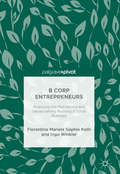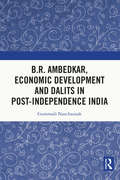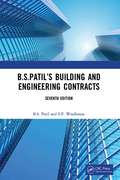- Table View
- List View
Awaking Europe in the Triple Global Crisis: The Birth Pangs of the Emerging Europe (New Horizons in European Politics series)
by Attila ÁghThis timely book examines the imminent dangers to European stability: the socio-economic crisis of global production that has reinforced structural inequalities; the climate crisis and its associated environmental degradation; and the onset and fallout of Covid-19. Placing the triple crisis in the context of EU, European and global geographies, it introduces a new conceptual framework to describe continuing systemic crisis and change in the EU. Based on a rich and varied array of source material, Attila Ágh offers a new insight into the future of European politics through twin conceptual pillars: ‘Awaking Europe’, which describes a Re-United Europe that brings together its key regions; and ‘Emerging Europe’, which refers to the upgrading of EU mechanisms to shape Europe as a global player through multilateralism. Presenting an integrative analysis of the triple crisis and its management, it describes and dissects the overarching creative crisis of the EU and the major direction of the Union’s strategy for renewal. Incisive and provocative, this book is critical reading for scholars and researchers in political science, European studies and economics, particularly those focusing on EU economic policy and the relationships between global powers. It will also benefit policymakers looking for innovative approaches to social investment and sustainable development.
The Awareness Code: The Secrets to Emotional Empowerment for Incredible Leadership
by Steve Tappin Wayne LintonThe Awareness Code is a ground-breaking blueprint on how you can increase your awareness and consequently improve your leadership skills. Through the frameworks, case studies and guidance found in this book, you will develop a style of leadership that will lead to clarity, productivity and drive on both an individual and collective basis. This is a valuable asset for both active and emerging leaders at every level of seniority which covers leadership in its broadest terms, from CEOs and Presidents to captains, teachers and line managers.The Awareness Code provides guidance that is not only applicable in a corporate environment but also has a broader relevance that will heighten leadership abilities in any sector or circumstance – from the football pitch to the political circus. The titular blueprint explicitly defines the attitudes and behaviours that limit our capabilities, while simultaneously providing solutions to these obstacle through valuable psychological insights that will allow readers to heighten their awareness and embrace new perspectives.
Awesomely Simple: Essential Business Strategies for Turning Ideas Into Action
by John SpenceThe six core strategies to elevate any business-and how to implement them-made simple What do the world's most successful companies and organization have in common? And what can you actually take away and use from their examples? Distilling the best fundamental business strategies, trusted advisor and strategist John Spence helps you take a hard look at your business and together develop specific plans and action steps that will allow you to dramatically improve the success of your company. Delivered in Spence's approachable and straightforward manner, Awesomely Simple reveals the six key strategies that create a foundation for achieving business excellence: Vivid Vision, Best People, A Performance-Oriented Culture, Robust Communication, A Sense of Urgency, and Extreme Customer Focus. Filled with case studies and clear action items, includes easy-to-follow guidelines for implementing the strategies in any organization no matter its mission or size After concisely breaking down each strategy, Spence gives specific examples, tips, tools, discussion questions and exercises for how to execute them successfully A perfect resource for business leaders, Awesomely Simple will help you turn ideas into positive action and achieve lasting business success.
Awesomely Simple: Essential Business Strategies for Turning Ideas Into Action
by John SpenceThe six core strategies to elevate any business-and how to implement them-made simple What do the world's most successful companies and organization have in common? And what can you actually take away and use from their examples? Distilling the best fundamental business strategies, trusted advisor and strategist John Spence helps you take a hard look at your business and together develop specific plans and action steps that will allow you to dramatically improve the success of your company. Delivered in Spence's approachable and straightforward manner, Awesomely Simple reveals the six key strategies that create a foundation for achieving business excellence: Vivid Vision, Best People, A Performance-Oriented Culture, Robust Communication, A Sense of Urgency, and Extreme Customer Focus. Filled with case studies and clear action items, includes easy-to-follow guidelines for implementing the strategies in any organization no matter its mission or size After concisely breaking down each strategy, Spence gives specific examples, tips, tools, discussion questions and exercises for how to execute them successfully A perfect resource for business leaders, Awesomely Simple will help you turn ideas into positive action and achieve lasting business success.
AWS Administration – The Definitive Guide
by Yohan WadiaLearn to design, build, and manage your infrastructure on the most popular of all the Cloud platforms—Amazon Web ServicesAbout This BookLearn how to leverage various Amazon Web Services (AWS) components and services to build a secure, reliable, and robust environment to host your applications onDeep dive into the core AWS service offerings with hands-on tutorials, real-world use case scenarios, and best practicesA self-paced, systematic, and step-by-step guide to learning and implementing AWS in your own environmentWho This Book Is ForThis book is for those who want to learn and leverage AWS. Although no prior experience with AWS is required, it is recommended that you have some hands-on experienceofLinux, Web Services, and basic networkingWhat You Will LearnA brief introduction to Cloud Computing and AWS accompanied by steps to sign up for your first AWS accountCreate and manage users, groups, and permissions using AWSS Identity and Access Management servicesGet started with deploying and accessing EC2 instances, working with EBS Volumes and SnapshotsCustomize and create your very own Amazon Machine ImageDesign and deploy your instances on a highly secured, network isolated environment using Amazon VPCEffectively monitor your AWS environment using specialized alarms, custom monitoring metrics, and much moreExplore the various benefits of Database-as-a-Service offerings and leverage them using Amazon RDS and Amazon DynamoDBTake an in-depth look at what's new with AWS, including EC2 Container Service and Elastic File SystemIn DetailAWS is at the forefront of Cloud Computing today. Many businesses are moving away from traditional datacenters and toward AWS because of its reliability, vast service offerings, lower costs, and high rate of innovation. Because of its versatility and flexible design, AWS can be used to accomplish a variety of simple and complicated tasks such as hosting multitier websites, running large scale parallel processing, content delivery, petabyte storage and archival, and lots more.Whether you are a seasoned sysadmin or a rookie, this book will provide you with all the necessary skills to design, deploy, and manage your applications on the AWS cloud platform. The book guides you through the core AWS services such as IAM, EC2, VPC, RDS, and S3 using a simple real world application hosting example that you can relate to. Each chapter is designed to provide you with the most information possible about a particular AWS service coupled with easy to follow hands-on steps, best practices, tips, and recommendations.By the end of the book, you will be able to create a highly secure, fault tolerant, and scalable environment for your applications to run on.Style and approach This in-depth and insightful guide is filled with easy-to-follow examples, real-world use cases, best practices, and recommendations that will help you design and leverage AWS.
AWS Cloud Computing Concepts and Tech Analogies: A guide to understand AWS services using easy-to-follow analogies from real life
by Ashish Prajapati Juan Carlos Ruiz Marco TamassiaThis book makes understanding cloud computing easy by providing relatable examples that simplify the complex technology. By drawing parallels between cloud concepts and everyday scenarios, we will demystify cloud tech, and once you start to understand it, learning cloud computing will be more enjoyable. This book will help you learn about cloud computing in general and AWS specifically, as you follow the journey of TrendyCorp—a fictitious company gearing up to move from traditional IT to cloud computing. You’ll shape your understanding of the cloud through scenarios of interactions between TrendyCorp’s new hires, seasoned IT professionals, external consultants, and the board of directors engaged in modernizing their applications. These characters’ discussions and actions are focused on learning about cloud services by drawing comparisons between the technology and examples taken from real life. Through this book, you’ll realize that cloud computing concepts have more in common with your day-to-day scenarios and situations than you’ve ever imagined. This book offers a conversational and entertaining narrative that anyone working in IT and looking to understand how the cloud works will be able to follow. By the end of it, you’ll have developed a clear and simplified perspective of cloud technologies.Key FeaturesLearn cloud concepts from AWS certified trainers using common analogies from real lifeGet to grips with the most commonly used services in the AWS cloudUnderstand how your knowledge from classical on premises IT can be applied to the CloudWhat you will learnImplement virtual servers in the cloudIdentify the best cloud storage options for a specific solutionExplore best practices for networking and databases in the cloudEnforce security with authentication and authorization in the cloudEffectively monitor applications in the cloudLeverage scalability and automation in the cloudGet the hang of decoupled and serverless architectureGrasp the fundamentals of containers and Blockchain in the cloudWho this book is forThis book is for anyone who wants to learn AWS cloud computing. It explains all the foundational concepts and mechanisms in detail. So basic knowledge of IT systems or terminologies (like server, storage, IP address, and web applications) is all that you need to get started with this book.
AWS DevOps Simplified: Build a solid foundation in AWS to deliver enterprise-grade software solutions at scale
by Akshay KapoorThe complete guide to increasing the DevOps maturity of your organization while adhering to AWS’ well-architected principlesKey FeaturesIncrease your organization’s DevOps maturity level from both strategic and tactical standpointGet hands-on AWS experience with ready-to-deploy code examples covering enterprise scenariosAdvance your career with practical advice to ensure customer satisfaction and stakeholder buy-inPurchase of the print or Kindle book includes a free PDF eBookBook DescriptionDevOps and AWS are the two key enablers for the success of any modern software-run business. DevOps accelerates software delivery, while AWS offers a plethora of services, allowing developers to prioritize business outcomes without worrying about undifferentiated heavy lifting. This book focuses on the synergy between them, equipping you with strong foundations, hands-on examples, and a strategy to accelerate your DevOps journey on AWS. AWS DevOps Simplified is a practical guide that starts with an introduction to AWS DevOps offerings and aids you in choosing a cloud service that fits your company's operating model. Following this, it provides hands-on tutorials on the GitOps approach to software delivery, covering immutable infrastructure and pipelines, using tools such as Packer, CDK, and CodeBuild/CodeDeploy. Additionally, it provides you with a deep understanding of AWS container services and how to implement observability and DevSecOps best practices to build and operate your multi-account, multi-Region AWS environments. By the end of this book, you’ll be equipped with solutions and ready-to-deploy code samples that address common DevOps challenges faced by enterprises hosting workloads in the cloud.What you will learnDevelop a strong and practical understanding of AWS DevOps servicesManage infrastructure on AWS using tools such as Packer and CDKImplement observability to bring key system behaviors to the surfaceAdopt the DevSecOps approach by integrating AWS and open source solutionsGain proficiency in using AWS container services for scalable software managementMap your solution designs with AWS’s Well-Architected FrameworkDiscover how to manage multi-account, multi-Region AWS environmentsLearn how to organize your teams to boost collaborationWho this book is forThis book is for software professional who build or operate software on AWS. If you have basic knowledge of AWS Console or CLI, this book will help you build or enhance your DevOps skills by developing a solid foundational understanding of AWS offerings. You’ll also find it useful if you’re looking to optimize your software delivery cycles and build reliable, cost-optimized, secure, and sustainable solutions on AWS.
AWS for Solutions Architects: Design your cloud infrastructure by implementing DevOps, containers, and Amazon Web Services
by Alberto ArtasanchezApply cloud design patterns to overcome real-world challenges by building scalable, secure, highly available, and cost-effective solutionsKey FeaturesApply AWS Well-Architected Framework concepts to common real-world use casesUnderstand how to select AWS patterns and architectures that are best suited to your needsEnsure the security and stability of a solution without impacting cost or performanceBook DescriptionOne of the most popular cloud platforms in the world, Amazon Web Services (AWS) offers hundreds of services with thousands of features to help you build scalable cloud solutions; however, it can be overwhelming to navigate the vast number of services and decide which ones best suit your requirements. Whether you are an application architect, enterprise architect, developer, or operations engineer, this book will take you through AWS architectural patterns and guide you in selecting the most appropriate services for your projects. AWS for Solutions Architects is a comprehensive guide that covers the essential concepts that you need to know for designing well-architected AWS solutions that solve the challenges organizations face daily. You'll get to grips with AWS architectural principles and patterns by implementing best practices and recommended techniques for real-world use cases. The book will show you how to enhance operational efficiency, security, reliability, performance, and cost-effectiveness using real-world examples. By the end of this AWS book, you'll have gained a clear understanding of how to design AWS architectures using the most appropriate services to meet your organization's technological and business requirements.What you will learnRationalize the selection of AWS as the right cloud provider for your organizationChoose the most appropriate service from AWS for a particular use case or projectImplement change and operations managementFind out the right resource type and size to balance performance and efficiencyDiscover how to mitigate risk and enforce security, authentication, and authorizationIdentify common business scenarios and select the right reference architectures for themWho this book is forThis book is for application and enterprise architects, developers, and operations engineers who want to become well-versed with AWS architectural patterns, best practices, and advanced techniques to build scalable, secure, highly available, and cost-effective solutions in the cloud. Although existing AWS users will find this book most useful, it will also help potential users understand how leveraging AWS can benefit their organization.
AWS Penetration Testing: Implement various security strategies on AWS using tools such as Kali Linux, Metasploit, and Nmap
by Jonathan HelmusGet to grips with security assessment, vulnerability exploitation, workload security, and encryption with this guide to ethical hacking and learn to secure your AWS environmentKey FeaturesPerform cybersecurity events such as red or blue team activities and functional testingGain an overview and understanding of AWS penetration testing and securityMake the most of your AWS cloud infrastructure by learning about AWS fundamentals and exploring pentesting best practicesBook DescriptionCloud security has always been treated as the highest priority by AWS while designing a robust cloud infrastructure. AWS has now extended its support to allow users and security experts to perform penetration tests on its environment. This has not only revealed a number of loopholes and brought vulnerable points in their existing system to the fore, but has also opened up opportunities for organizations to build a secure cloud environment. This book teaches you how to perform penetration tests in a controlled AWS environment.You'll begin by performing security assessments of major AWS resources such as Amazon EC2 instances, Amazon S3, Amazon API Gateway, and AWS Lambda. Throughout the course of this book, you'll also learn about specific tests such as exploiting applications, compromising Identity and Access Management (IAM) keys, testing permissions flaws, and discovering weak policies. Moving on, you'll discover how to establish private-cloud access through backdoor Lambda functions. As you advance, you'll explore the no-go areas where users can't make changes due to vendor restrictions, and find out how you can avoid being flagged to AWS in these cases. Finally, this book will take you through tips and tricks for securing your cloud environment in a professional way.By the end of this penetration testing book, you'll have become well-versed in a variety of ethical hacking techniques for securing your AWS environment against modern cyber threats.What you will learnSet up your AWS account and get well-versed in various pentesting servicesDelve into a variety of cloud pentesting tools and methodologiesDiscover how to exploit vulnerabilities in both AWS and applicationsUnderstand the legality of pentesting and learn how to stay in scopeExplore cloud pentesting best practices, tips, and tricksBecome competent at using tools such as Kali Linux, Metasploit, and NmapGet to grips with post-exploitation procedures and find out how to write pentesting reportsWho this book is forIf you are a network engineer, system administrator, or system operator looking to secure your AWS environment against external cyberattacks, then this book is for you. Ethical hackers, penetration testers, and security consultants who want to enhance their cloud security skills will also find this book useful. No prior experience in penetration testing is required; however, some understanding in cloud computing or AWS cloud is recommended.
Axel Honneth and the Critical Theory of Recognition (Political Philosophy and Public Purpose)
by Volker SchmitzThe critical theory of the Frankfurt School has undergone numerous and at times fundamental changes over the last ninety years. Since the late 1960s, it has been characterized primarily by Jürgen Habermas’s “communicative turn” and a focus on normative foundations. Today, that “second generation” exists side-by-side with a “third generation” represented most prominently by Axel Honneth’s turn toward recognition, ethical life, and the normative reconstruction of social institutions. This volume brings together critical voices on the state and direction of Frankfurt School theory today by examining Honneth’s theory in light of both current challenges and the intellectual and political ambitions that have shaped the tradition from its beginning. United in their strong commitment to critical scholarship, the authors collected here approach Honneth’s work from different backgrounds, employ a wide variety of methodologies, and write in different genres, ranging from the sober scholarly analysis to programmatic and political appeals. The collective aim of these reflections is not to reject Honneth’s theory but to build upon his work and incorporate his themes of recognition and social freedom into a new project of critical theory that can prove adequate to the political and social crises of our time.
Axes of Sustainable Development and Growth in India: Essays in Honour of Professor Jyoti K. Parikh (Sustainable Development Goals Series)
by Piyush Tiwari Kirit ParikhThis book is written by prominent academics and practitioners, exploring problems and opportunities of growth in different aspects of sustainable development. The overarching themes running throughout the book are energy access, policy, climate change, human development and resource allocation in the context of India. The book will benefit policymakers and researchers with its inclusion of new evidence and solutions to meet developmental challenges.
Axial Shift: City Subsidiarity and the World System in the 21st Century
by Benjamen GussenThis book uses historical analysis, constitutional economics, and complexity theory to furnish an account of city subsidiarity as a legal, ethical, political, and economic principle. The book contemplates subsidiarity as a constitutional principle, where cities would benefit from much wider local autonomy. Constitutional economics suggests an optimal limit to jurisdictional footprints (territories). This entails preference for political orders where sovereignty is shared between different cities rather states where capital cities dominate. The introduction of city subsidiarity as a constitutional principle holds the key to economic prosperity in a globalizing world. Moreover, insights from complexity theory suggest subsidiarity is the only effective response to the ‘problem of scale.’ It is a fitness trait that prevents highly complex systems from collapsing. The nation-state is a highly complex system within which cities function as ‘attractors.’ The collapse of such systems would ensue if there were strong coupling between attractors. Such coupling obtains under legal monism. Only subsidiarity can make the eventuality of collapse improbable. The emergent and self-organizing properties of subsidiarity entail a shift in policy emphasis towards cities with a wide margin of autonomy.
Axiomatic Bargaining Game Theory (Theory and Decision Library C #9)
by H.J. PetersMany social or economic conflict situations can be modeled by specifying the alternatives on which the involved parties may agree, and a special alternative which summarizes what happens in the event that no agreement is reached. Such a model is called a bargaining game, and a prescription assigning an alternative to each bargaining game is called a bargaining solution. In the cooperative game-theoretical approach, bargaining solutions are mathematically characterized by desirable properties, usually called axioms. In the noncooperative approach, solutions are derived as equilibria of strategic models describing an underlying bargaining procedure. Axiomatic Bargaining Game Theory provides the reader with an up-to-date survey of cooperative, axiomatic models of bargaining, starting with Nash's seminal paper, The Bargaining Problem. It presents an overview of the main results in this area during the past four decades. Axiomatic Bargaining Game Theory provides a chapter on noncooperative models of bargaining, in particular on those models leading to bargaining solutions that also result from the axiomatic approach. The main existing axiomatizations of solutions for coalitional bargaining games are included, as well as an auxiliary chapter on the relevant demands from utility theory.
Axiomatic choice models and duality (Tilburg Studies in Economics #3)
by H.N. WeddepohlEvery day people frequently have to make a choice. For practical and scientific reasons therefore it is interesting to know what choices they make and how they arrive at them. An approach to this question can be made via psychology. However, it is also possible to approach it on a more formal basis. In this book Dr. Wedde pohl describes the logical structure of an individual's rational choice. It is this formal, logical approach to the decision problem that makes the book interesting reading matter for all those who are engaged in the study of individual choice. The introduction apart this study may be divided into two parts. The first part, consisting of chapters II and III, deals with choice theory on a very abstract level. In chapter II some mathematical concepts are presented and in chapter III two related choice models are treated, the first one based on preferences, the second one on choice functions. The second part consists of chapters IV, V and VI and covers consumer choice theory. After the pre sentation of the mathematical tools, two models that are extensions of the models of chapter III are dealt with. In the discussion of consumer choice theory the concept of duality plays an important role and it is found that duality is closely related to the notion of favourability introduced in chap ter II I. Mr. Weddepohl's study forms an introduction to a larger research project to develop the theory of collective choice.
Axiomatic Design: Eine Methode zur serviceorientierten Modellierung
by René FiegeRené Fiege adaptiert die aus dem Maschinenbau stammende Methode Axiomatic Design für die Modellierung von serviceorientierten Architekturen. Er zeigt, dass die Methode die erforderlichen Architekturprinzipien stärker fördern kann als alternative Modellierungsmethoden für SOA.
Axiomatic Models of Bargaining (Lecture Notes in Economics and Mathematical Systems #170)
by A.E. RothThe problem to be considered here is the one faced by bargainers who must reach a consensus--i.e., a unanimous decision. Specifically, we will be consid ering n-person games in which there is a set of feasible alternatives, any one of which can be the outcome of bargaining if it is agreed to by all the bargainers. In the event that no unanimous agreement is reached, some pre-specified disagree ment outcome will be the result. Thus, in games of this type, each player has a veto over any alternative other than the disagreement outcome. There are several reasons for studying games of this type. First, many negotiating situations, particularly those involving only two bargainers (i.e., when n = 2), are conducted under essentially these rules. Also, bargaining games of this type often occur as components of more complex processes. In addi tion, the simplicity of bargaining games makes them an excellent vehicle for studying the effect of any assumptions which are made in their analysis. The effect of many of the assumptions which are made in the analysis of more complex cooperative games can more easily be discerned in studying bargaining games. The various models of bargaining considered here will be studied axioma- cally. That is, each model will be studied by specifying a set of properties which serve to characterize it uniquely.
Axiomatic Utility Theory under Risk: Non-Archimedean Representations and Application to Insurance Economics (Lecture Notes in Economics and Mathematical Systems #461)
by Ulrich SchmidtThe first attempts to develop a utility theory for choice situations under risk were undertaken by Cramer (1728) and Bernoulli (1738). Considering the famous St. Petersburg Paradox! - a lottery with an infinite expected monetary value -Bernoulli (1738, p. 209) observed that most people would not spend a significant amount of money to engage in that gamble. To account for this observation, Bernoulli (1738, pp. 199-201) proposed that the expected monetary value has to be replaced by the expected utility ("moral expectation") as the relevant criterion for decision making under risk. However, Bernoulli's 2 argument and particularly his choice of a logarithmic utility function seem to be rather arbitrary since they are based entirely on intuitively 3 appealing examples. Not until two centuries later, did von Neumann and Morgenstern (1947) prove that if the preferences of the decision maker satisfy cer tain assumptions they can be represented by the expected value of a real-valued utility function defined on the set of consequences. Despite the identical mathematical form of expected utility, the theory of von Neumann and Morgenstern and Bernoulli's approach have, however, IFor comprehensive discussions of this paradox cf. Menger (1934), Samuelson (1960), (1977), Shapley (1977a), Aumann (1977), Jorland (1987), and Zabell (1987). 2Cramer (1728, p. 212), on the other hand, proposed that the utility of an amount of money is given by the square root of this amount.
The Axiomatics of Economic Design, Vol. 1: An Introduction to Theory and Methods (Studies in Choice and Welfare)
by William ThomsonThis textbook is Volume 1 of a two-volume set on the axiomatics of economic design. Its central argument is that economic institutions are not God-given: they are man-made. Their ultimate goal is to promote social welfare. The book describes the axiomatic approach to design. It consists in the formulation of criteria of desirability of solution mappings, and of the examination of their logical implications when imposed in various combinations. Its goal is to identify as precisely as possible the line that separates those combinations of desiderata that are compatible and those that are not. The end product of axiomatic work are menus of choices for practitioners to choose from when they have to make a decision.The first volume offers pedagogical coverage of the axiomatic approach to economic design, in the form of answers to questions posed by a young person curious about it. It introduces readers to what motivates economic design. It continues with the mathematical representation of a class of allocation problems. The bulk of the volume is to present structured inventories of the field of axioms, arranged by format first, and content next. These chapters are followed by a user's manual on the axiomatic method. Lastly, the volume discusses how economic design can be aided by other disciplines, in particular philosophy, mathematics, and computer science.
Azure Architecture Explained: A comprehensive guide to building effective cloud solutions
by David Rendón Brett HargreavesEnhance your career as an Azure architect with cutting-edge tools, expert guidance, and resources from industry leadersKey FeaturesDevelop your business case for the cloud with technical guidance from industry expertsAddress critical business challenges effectively by leveraging proven combinations of Azure servicesTackle real-world scenarios by applying practical knowledge of reference architecturesPurchase of the print or Kindle book includes a free PDF eBookBook DescriptionAzure is a sophisticated technology that requires a detailed understanding to reap its full potential and employ its advanced features. This book provides you with a clear path to designing optimal cloud-based solutions in Azure, by delving into the platform's intricacies. You’ll begin by understanding the effective and efficient security management and operation techniques in Azure to implement the appropriate configurations in Microsoft Entra ID. Next, you’ll explore how to modernize your applications for the cloud, examining the different computation and storage options, as well as using Azure data solutions to help migrate and monitor workloads. You’ll also find out how to build your solutions, including containers, networking components, security principles, governance, and advanced observability. With practical examples and step-by-step instructions, you’ll be empowered to work on infrastructure-as-code to effectively deploy and manage resources in your environment. By the end of this book, you’ll be well-equipped to navigate the world of cloud computing confidently.What you will learnImplement and monitor cloud ecosystem including, computing, storage, networking, and securityRecommend optimal services for performance and scaleProvide, monitor, and adjust capacity for optimal resultsCraft custom Azure solution architecturesDesign computation, networking, storage, and security aspects in AzureImplement and maintain Azure resources effectivelyWho this book is forThis book is an indispensable resource for Azure architects looking to develop cloud-based services along with deploying and managing applications within the Microsoft Azure ecosystem. It caters to professionals responsible for crucial IT operations, encompassing budgeting, business continuity, governance, identity management, networking, security, and automation. If you have prior experience in operating systems, virtualization, infrastructure, storage structures, or networking, and aspire to master the implementation of best practices in the Azure cloud, then this book will become your go-to guide.
B Corp Entrepreneurs: Analysing the Motivations and Values behind Running a Social Business
by Florentine Mariele Roth Ingo WinklerHighlighting the motivations of B Corp entrepreneurs in Chile, this book explores the phenomenon behind for-profit organisations that are committed to social and ecological sustainability as well as human welfare. By examining the personal and social drivers of businesses which are not solely focused on profit-making, the authors reveal a dual orientation that is an important factor in the creation of hybrid organisations. Offering an in-depth study of B Corp entrepreneurs in Chile, the largest B Corp community outside of North America, this pioneering book challenges dominant assumptions that there is only one ideal type of entrepreneur and argues that the values of the purely profit-driven and purely social-driven do in fact intersect. An enlightening read for researchers of social business and sustainability, this book analyses perceptions towards success, and the desire to solve environmental problems, underlining a fundamental aspect of the entrepreneur’s personal value structure.
B Corp Entrepreneurs: Analysing the Motivations and Values behind Running a Social Business
by Florentine Mariele Roth Ingo WinklerHighlighting the motivations of B Corp entrepreneurs in Chile, this book explores the phenomenon behind for-profit organisations that are committed to social and ecological sustainability as well as human welfare. By examining the personal and social drivers of businesses which are not solely focused on profit-making, the authors reveal a dual orientation that is an important factor in the creation of hybrid organisations. Offering an in-depth study of B Corp entrepreneurs in Chile, the largest B Corp community outside of North America, this pioneering book challenges dominant assumptions that there is only one ideal type of entrepreneur and argues that the values of the purely profit-driven and purely social-driven do in fact intersect. An enlightening read for researchers of social business and sustainability, this book analyses perceptions towards success, and the desire to solve environmental problems, underlining a fundamental aspect of the entrepreneur’s personal value structure.
B.R. Ambedkar, Economic Development and Dalits in Post-Independence India
by Gummadi NancharaiahThis book examines Ambedkar the economist. It foregrounds his economic ideas within the context of post-independence India. It also studies the socio-economic status of Dalits in the country focusing on Ambedkar’s views on inclusive and equitable growth. The volume: · Focuses on the economic writings of Ambedkar and looks at his views on caste and its economic implications, monetary and fiscal systems, as well as exchange rate and trade; · Discusses issues like land reforms and agrarian change, poverty, higher education and human rights from a Dalit perspective; · Examines the relevance of Ambedkar’s economic ideas for contemporary India. Drawing on interdisciplinary research methods, this book will be of great interest to scholars and researchers of economics, political science, development studies, history, human rights, and South Asian studies.
B.R. Ambedkar, Economic Development and Dalits in Post-Independence India
by Gummadi NancharaiahThis book examines Ambedkar the economist. It foregrounds his economic ideas within the context of post-independence India. It also studies the socio-economic status of Dalits in the country focusing on Ambedkar’s views on inclusive and equitable growth. The volume: · Focuses on the economic writings of Ambedkar and looks at his views on caste and its economic implications, monetary and fiscal systems, as well as exchange rate and trade; · Discusses issues like land reforms and agrarian change, poverty, higher education and human rights from a Dalit perspective; · Examines the relevance of Ambedkar’s economic ideas for contemporary India. Drawing on interdisciplinary research methods, this book will be of great interest to scholars and researchers of economics, political science, development studies, history, human rights, and South Asian studies.
B.S.Patil’s Building and Engineering Contracts, 7th Edition
by B.S. Patil S.P. WoolhouseFrom the standpoint of practising engineers, architects and contractors, the law of contract is the most important one and, from preparation of technical documents to its execution and in the determination of disputes, the engineer or architect must have relevant knowledge. This book acts as a practical guide to building and engineering contracts. All points are explained with illustrations gathered from decided court cases. This book covers the substantive law of contract applicable to building and engineering contracts with updated noteworthy judgments. FIDIC conditions are mentioned at appropriate places with a global focus. Key Features: Guide for a full and thorough understanding of the contractual undertakings of the civil engineering industry, primarily in India Discusses specific conditions which are fertile sources of disputes, referring to and commenting upon the FIDIC conditions Covers internationally adopted standard form conditions of contract with analysis, discussions and interpretations, with decided court cases from India and abroad Focuses on technical civil engineering aspects Addresses cases from countries including UK, US, Canada, Australia, New Zealand and India
B.S.Patil’s Building and Engineering Contracts, 7th Edition
by B.S. Patil S.P. WoolhouseFrom the standpoint of practising engineers, architects and contractors, the law of contract is the most important one and, from preparation of technical documents to its execution and in the determination of disputes, the engineer or architect must have relevant knowledge. This book acts as a practical guide to building and engineering contracts. All points are explained with illustrations gathered from decided court cases. This book covers the substantive law of contract applicable to building and engineering contracts with updated noteworthy judgments. FIDIC conditions are mentioned at appropriate places with a global focus. Key Features: Guide for a full and thorough understanding of the contractual undertakings of the civil engineering industry, primarily in India Discusses specific conditions which are fertile sources of disputes, referring to and commenting upon the FIDIC conditions Covers internationally adopted standard form conditions of contract with analysis, discussions and interpretations, with decided court cases from India and abroad Focuses on technical civil engineering aspects Addresses cases from countries including UK, US, Canada, Australia, New Zealand and India
